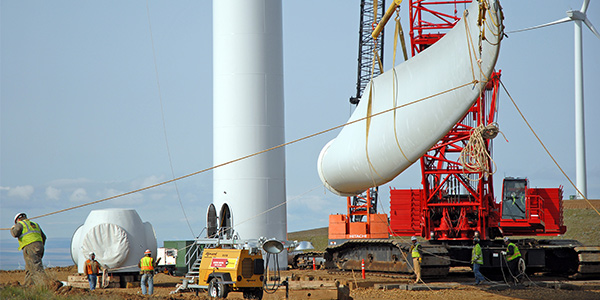By Tom Kleckner
The American Wind Energy Association on Thursday reported a “banner year” for the wind industry in 2019 but also acknowledged the storm clouds gathering on the horizon.
John Hensley, AWEA’s vice president of research and analytics, said 25 GW of projects — representing $35 billion in investment capital and tens of thousands of jobs — are at risk because of the COVID-19 pandemic. He pointed to national lockdowns in India and Spain and a slowdown in China as disrupting the industry’s supply chain and delaying some projects.
“The U.S wind industry is not immune to COVID-19 yet,” Hensley said. “We’re being impacted like any other industry.”
Indeed, General Electric’s LM Wind Power plant in Grand Forks, N.D., announced it will close for at least 14 days as state officials linked 128 positive cases of the coronavirus to the factory, which makes turbine blades.

Repowering activities at Pacificorp’s Goodnoe Hills Wind Farm in Washington | AWEA
The industry faces several challenges. It and other clean-energy sectors lost more than 106,000 jobs in March, according to a report by BW Research Partnership prepared for climate advocacy group E2. And those sectors will have a tough time arguing to the Republican-controlled Senate for inclusion in any further stimulus legislation that Congress may — or may not — pass. (See Renewable Tax Credit Extensions Not in Stimulus Bill.)
Hensley said AWEA is working with Congress to gain some “immediate flexibility” and stave off further losses. He said an extension of the safe harbor continuity window for wind projects begun in 2016 and 2017 “will address the immediate impact the developers are experiencing.”
Having learned that tax equity is becoming a concern, AWEA is also pursuing additional relief in the form of direct tax payments.
“Congress has been supportive,” Hensley said. “We do hope to have their continued support, so that clean energy can continue creating jobs.”

Wind power capacity grew 9.6% in 2019, with an additional 9.1 GW pushing total capacity to 105.6 GW. | AWEA
Otherwise, AWEA had nothing but good news to report. According to its “Wind Powers America 2019 Annual Report,” wind turbines are now the single largest provider of renewable energy in the U.S., surpassing hydro power to account for 7.2% of the nation’s electricity production.
Wind capacity cracked the 100-GW barrier in 2019, reaching 105.6 GW with 9.1 GW of new capacity and $14 billion in new projects. AWEA said the industry employed 120,000 people and provided $1.6 billion in local payments to communities and landowners last year.
Developers delivered 55 projects in 19 states during 2019, with Texas and Iowa both adding more than 1 GW of wind capacity. Texas has 3.9 GW of wind capacity and Iowa 1.7 GW. Wind energy provided more than 20% of generation in Iowa, Kansas, Maine, North Dakota, Oklahoma and South Dakota.
All seven U.S. grid operators set records last year for wind output and, with the exception of ISO-NE, for wind penetration. ERCOT produced a record 19,672 MW of wind energy last year, and SPP established a top mark for wind penetration at 68.8% (since raised to 72.4% on April 2).

ISOs and RTOs set wind output and penetration records in 2019. | AWEA
Utility and corporate buyers, taking advantage of wind costs that have fallen more than 70% during the last decade, also set records in 2019 with more than 8.7 GW of new power purchase agreements. Berkshire Hathaway Energy and Xcel Energy dominate the market with more than 16 GW of capacity between them; Google Energy is the only corporate buyer among the top 10, with 1.4 GW of capacity.
AWEA said the industry began 2020 with a near-record project pipeline of 44 GW of capacity either under construction or in advanced stages of development. Hensley said that while the organization continues to see projects moving forward, “It’s too early to know the full extent of those delays on construction plans.”
“Affordable, reliable energy is not a luxury — it’s a necessity,” AWEA CEO Tom Kiernan said in a statement. “While we are now working to mitigate the significant disruptions from COVID-19, we know that we will meet these challenges with strong industry momentum.”



